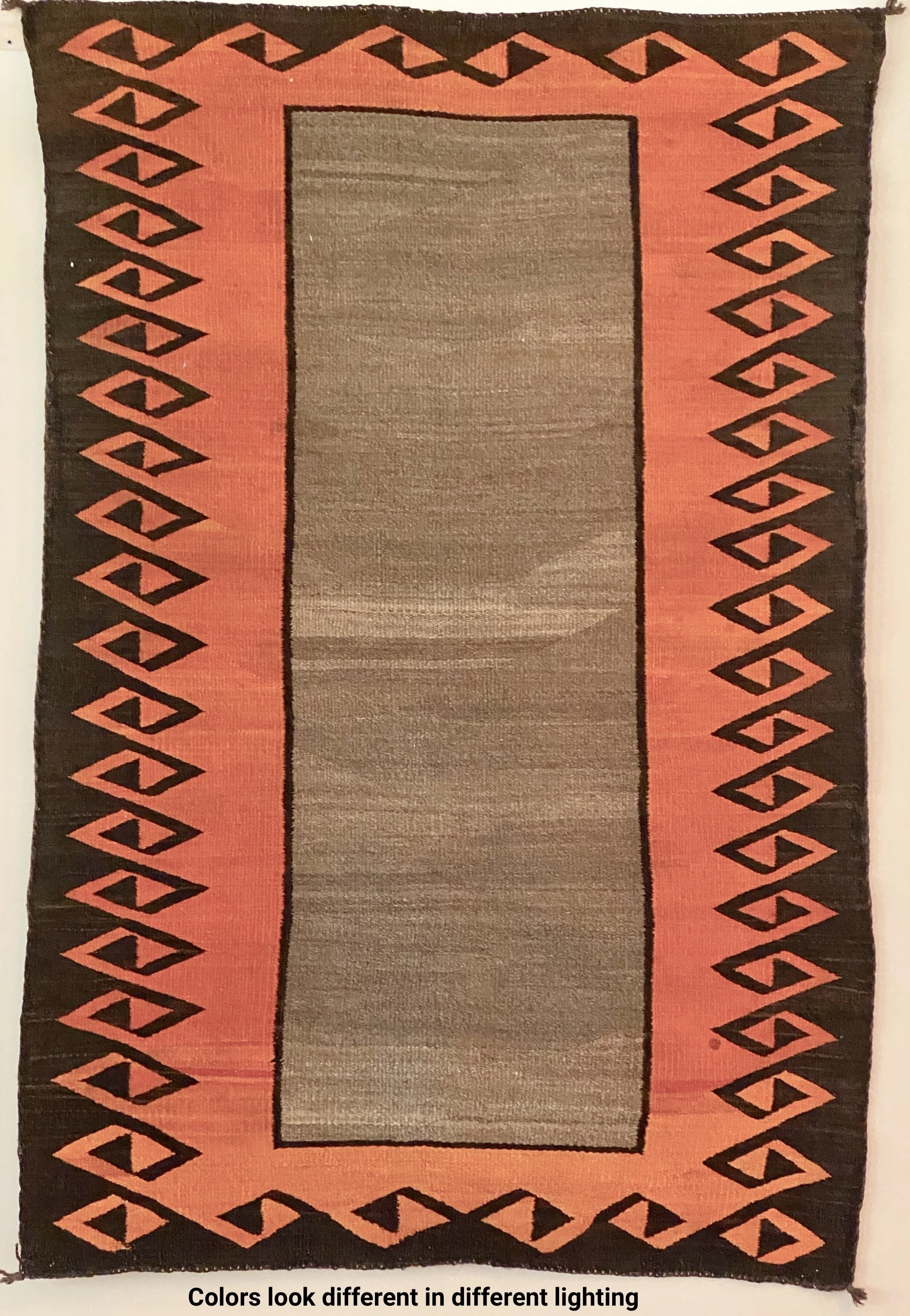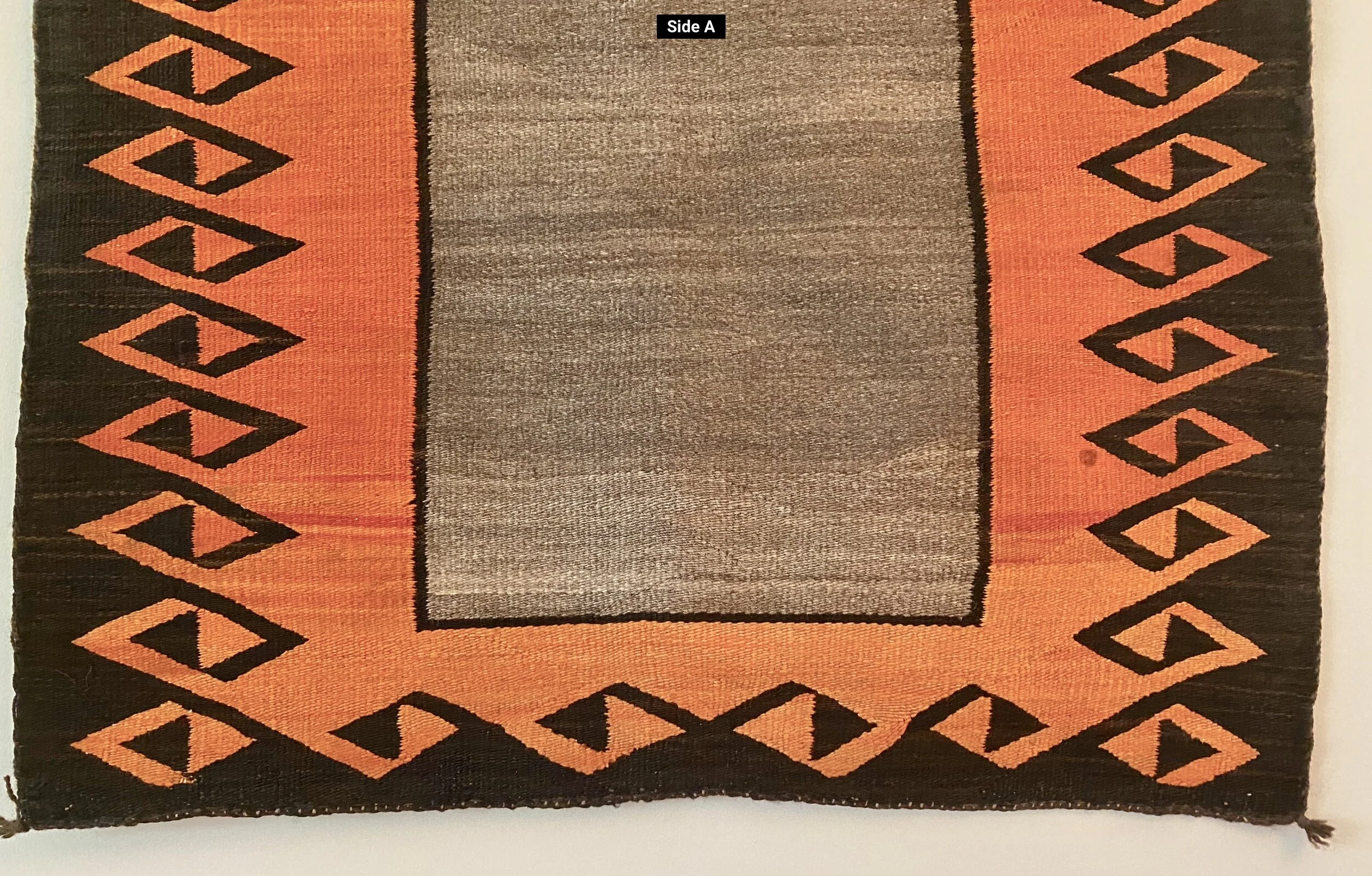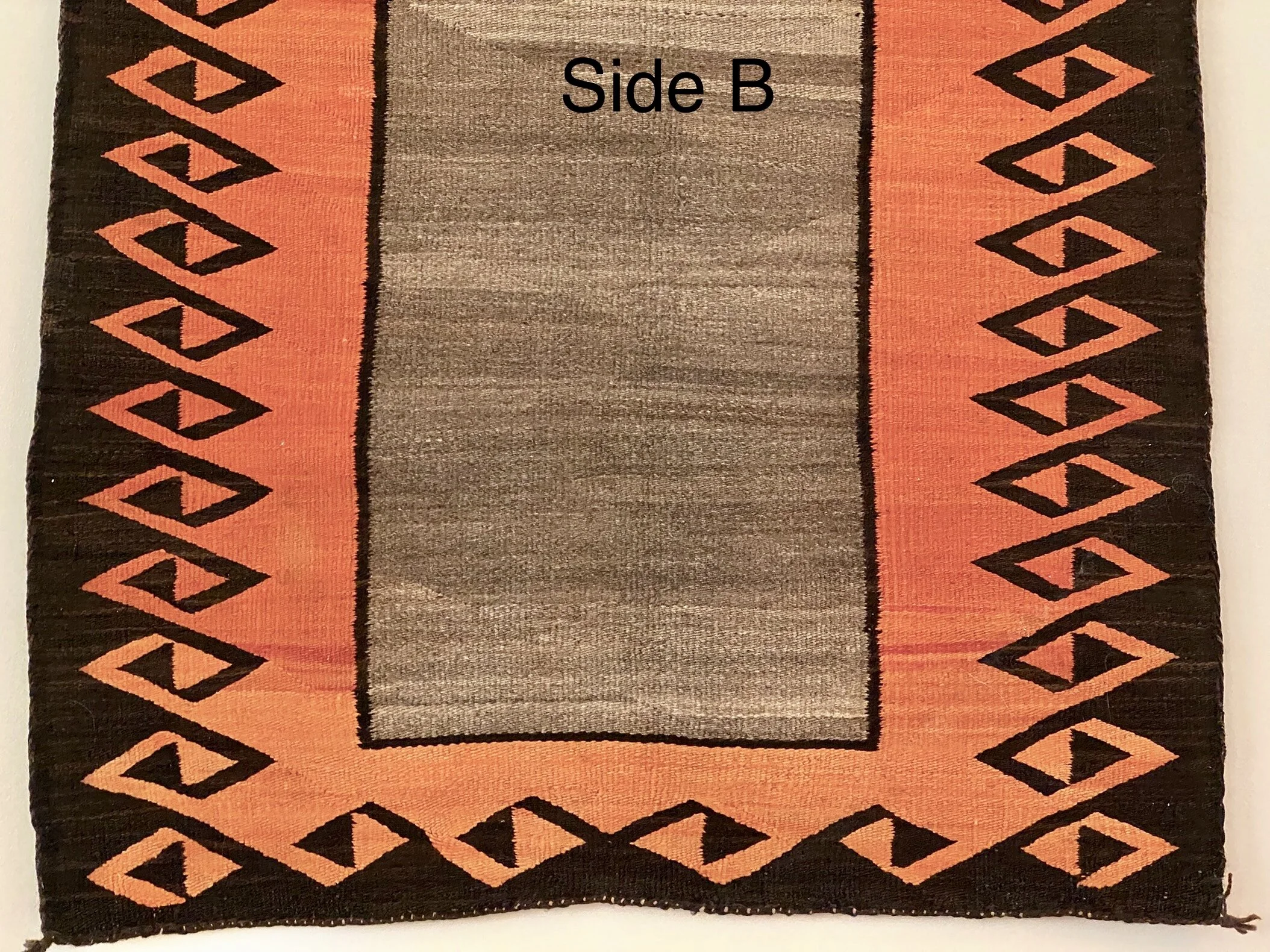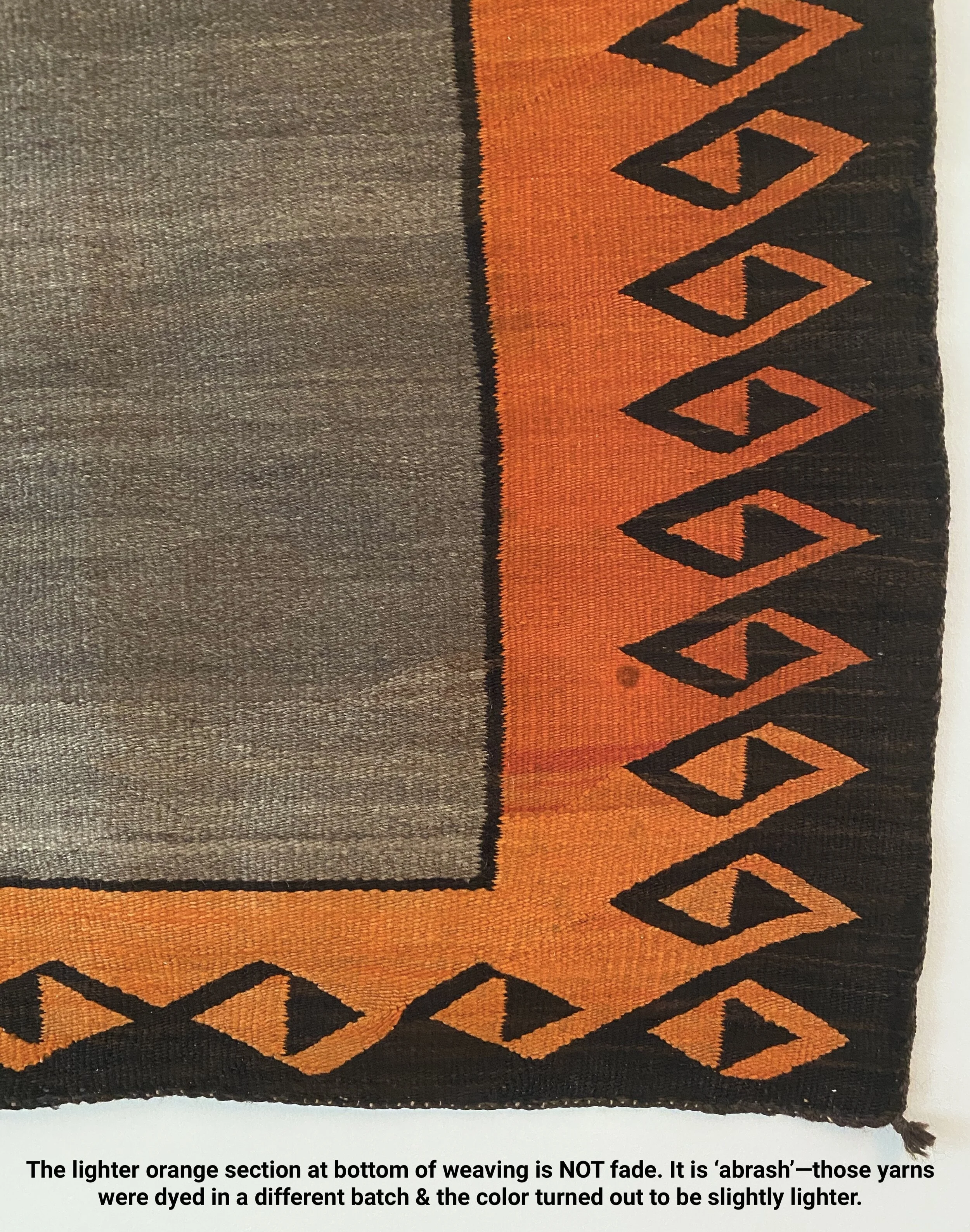Navajo double saddle blanket, c. 1920-1930. 90+ yr-old, superb abstract art. [W9733]
Navajo double saddle blanket, c. 1920-1930. 90+ yr-old, superb abstract art. [W9733]
PRICE: $4200. SALE $3800 POR. ‘POR’ means please CALL 703-801-2565 to discuss purchase options including “on-approval” purchase.
Origin: Diné [Navajo], Navajo Nation, c.1920-30 [W9733]
About 100 years ago, this “double” saddle blanket was hand-woven on a rustic upright loom by a Diné woman with great artistic vision. Navajo saddle blankets were woven to go under a horse’s saddle to prevent saddles from rubbing sores into a horse’s back. “Double” means it was made long enough to be folded in half [doubled] under the saddle to create a thicker pad; but still wide and long enough so that at least the blanket border would hang out below the saddle so its borders were viewable around the saddle sides and back. So an elaborate, colorful border on a saddle blanket provided an attractive, dramatic frame around the saddle.
This saddle blanket is the “real deal”. Uniquely envisioned and created by the Diné weaver to be used in real life as a Diné saddle blanket—not woven for sale to tourists. 90-100 years old! That is a reflection of the high quality of the weaving—to survive for years as an actual saddle blanket means that the wool was very well and tightly spun and tightly woven so that constant saddle wear would not disintegrate the weaving.
Historically [before some white traders started ‘pushing’ certain designs], a Diné weaver envisioned her design before ever starting to weave—envisioned it all in her mind. NO designing on paper or replicating a design some trader wanted. That was true with this Diné ‘grandmother’ who had superb artistic vision in creating this saddle blanket that is beautiful abstract art.
She created a dramatic border with the dark brown outer border framing the bold inner orange border. She made this even more dramatic by creating positive/negative visual effect with meandering, linked hooks where the dark brown and orange borders meet. Visually stunning, unique, original abstract art—executed with superb technical skill! I have never seen any other Diné saddle blankets with this beautiful design using a bold orange dye.
This complex design indicates the weaver really cared about her weaving because it took hundreds more hours of spinning, dyeing and weaving for her to produce this saddle blanket design. A simple border of 1 natural wool color would have taken many fewer hours of challenging work. Her design would have had dramatic visual impact when folded double under a saddle because that stunning, dark brown and bold orange border would be exposed, framing the saddle edges.
Her beautiful border is also a bold ‘frame’ for the center of her saddle blanket, which itself forms a beautiful abstract art panel. It’s composed of natural brown variegated Navajo sheep wool that has natural color variations of shades of brown. Her use of differing shades and patterns of the natural variegated wool reminds me of the differing colors of sedimentary rock layers so characteristic of the Diné landscape. Her alternating light and dark horizontal lines of the variegated wool also remind me of the shadow effects on the landscape as the light shifts as clouds drift across the awesome western sky!
Notice that those variegated layers of wool are interrupted by long slanted lines in the weaving—some slanted to the left, some slanted to the right. Those lines are in fact characteristic of antique Diné weaving. Here’s a simplified explanation of what they are. In historic Diné weaving, seldom was a weaving completed in ‘one sitting’ in one time period. Instead, different sections of weft were progressively woven [filled in] at different times, and were woven with a slant on the unfinished side of the weft. When the weaving was resumed to create the next weft section, the Diné weaver used an innovative weaving technique to join the new weft section to the previous weft section. That technique of joining weft sections resulted in a structurally sound, finished weaving, but left those periodic slanted lines in the weaving.
Traders dubbed such lines, “lazy lines”, which is an offensive insult, wrongly implying they are there because the weavers were “lazy”. That’s an ABSURD, IDIOTIC, IGNORANT LIE, ...and is RACIST. So I personally refuse to use that false, offensive term--& I encourage you to refuse to use it. Instead, use the alternative, fact-based term I coined: “smart lines”. “Smart” because they were a structurally sound way of joining individually-woven weft sections into an integrated, strong whole. But also very smart in enabling efficient, effective, superb weaving under historically challenging conditions. Historic Diné weavings resulted from thousands of hours of hard work just to raise the sheep to produce the wool. Then the dedicated weaver had to clean [& in some cases, dye the wool], and spin it before even beginning the weaving, which itself took hundreds or thousands of hours at the loom. There’s NO “lazy” in Diné weaving!
When I view this weaving hanging on a wall vertically, in the center field I see abstract outlines of mountains and mesas. It reminds me of the long distance view one has of that wonderful, unique landscape in the Diné homeland. I can visualize her sitting at her outdoor upright loom, inspired by the surrounding landscape of her Diné homeland, to recreate it in abstract form in her weaving. Awesome! Was it the weaver’s intention to depict an abstract landscape with outlines of mountains or mesas? I don’t know. But I personally think it’s highly unlikely those outlines and patterns could have happened randomly without specific intent & careful weaving by the weaver. Regardless of whether the weaver intended to represent her homeland landscape, the center panel is an awesome abstract geometric art design that I believe was intentional and consistent with this creative weaver’s vision!
Dimensions: approximating 34 x 53”.
CONDITION: professionally cleaned; repairs to minor selvedge breaks & warp/weft breaks on corners. No fade; no dye bleed; no moth damage; no toxic moth treatments; no odors of tobacco, chemicals, fragrance; no mold. We are non-smokers; we do NOT use chemical moth repellants. Our house is MOLD-free, fragrance-free, chemical-free, Covid-free.
Color variations. Variations in the weaving’s plain brown center field are due to natural variegation in the brown sheep wool, although I believe the weaver purposely chose certain variations to create a more interesting design. There also are some variations in color of the dark brown outer border—those also are due to color variation in the natural dark brown sheep wool.
Orange color variation is NOT fade. Notice the lower section of the weaving’s orange border is a lighter shade of synthetic-dyed orange wool [see photos]. That is NOT fade. Rather, it is orange-dyed wool from a 2nd, different dye batch, in which the wool came out a lighter shade of orange instead of the darker orange. That happens when a weaver’s original batch of dyed wool runs out and to finish the weaving, she had to prepare a 2nd batch of orange-dyed wool. In that situation, it is nearly impossible to ‘match’ the previous dye batch color shade. Weaving professionals refer to such dyed color variations as “abrash”. Those of us who love antique Diné hand-woven textile art, appreciate weavings with abrash in them. I personally love the visual effect of the orange abrash in this weaving—for me it adds to the overall effect of this wonderful abstract art creation.
We love and admire antique Navajo weavings for their awesome beauty and for their unique artistic vision & creativity--they 'move' us spiritually, aesthetically and emotionally. They provide a ‘window’ into Diné history and culture. And we are awed in knowing their creation requires hundreds & even thousands of hours of dedicated hand labor using knowledge and skills inherited from Diné ancestors.
Materials: hand-spun Navajo sheep wool. Warps: 7/inch; natural white/beige wool. Wefts: 28-30/inch; natural variegated light brown, dark brown & black wool; synthetic-dyed dark & light orange wool . Selvedge cords: natural black & dark brown wool.
Written Authenticity Guarantee: Navajo hand-woven double saddle blanket, c.1920-30; approximating 34 x 53”. Warps: Navajo hand-spun sheep wool; 7/inch of natural white/beige wool. Wefts: Navajo hand-spun sheep wool; 28-30 weft/inch of 5 colors—natural black, light brown, dark brown; & synthetic-dyed dark orange & light orange. Selvedge cords of Navajo hand-spun natural black and dark brown sheep wool.
Buy without worries: (1) written authenticity guarantee; member-Authentic Tribal Art Dealers Asso. [ATADA]; (2) we are COVID-FREE--we, our inventory & our packing materials have been well protected from any Covid virus exposures; (3) our home & inventory storage is chemical-free, fragrance-free, mold-free, to protect our & YOUR HEALTH. Click this link: How we PROTECT your HEALTH






